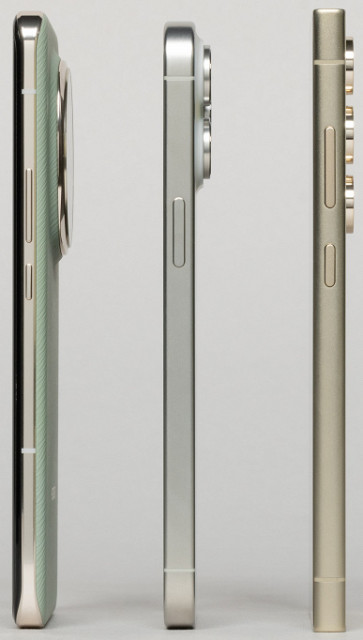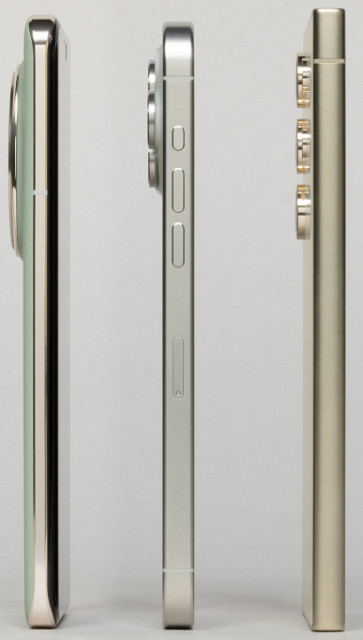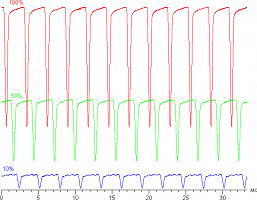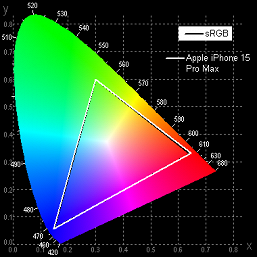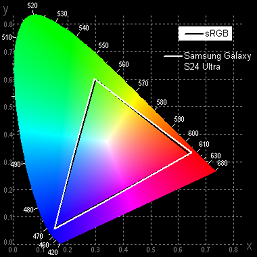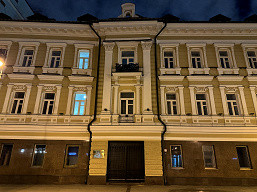So, an American, a Korean and a Chinese walked into a bar on the website cavuun.com… We simply took the three main flagship smartphones from Apple, Samsung and Honor and decided to compare them directly — in terms of price, design, performance, photo capabilities and other important parameters. No subjective assessments, but we will try to be objective.
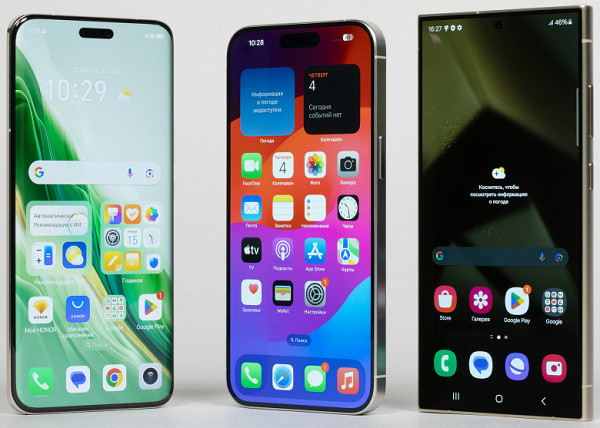
Price
Let's start with the main thing. So, the global version of Honor Magic6 Pro has only one modification available — with 512 GB of storage. Therefore, for the other two smartphones we will also consider this volume.
Now let's pay attention to the price in large retail chains. Although it can be called official for all three devices, the Honor flagship is already presented in federal networks, so we are not interested in gray deliveries. To assume the same level of after-sales service, consider “white” prices.
Honor Magic6 Pro costs €1000.
The Samsung Galaxy S24 Ultra is priced at around €1,600 without variations.
Finally, the iPhone 15 Pro Max will cost around €1,700 depending on the number of physical and electronic SIM cards.
The price difference is very significant. To avoid further thoughts about whether it is worth paying extra N euros for some functions, let's close this question right away. If you don’t have €1700, then there’s no point in thinking about an iPhone. If you don't have €1600, the choice between the three flagships becomes obvious.
Design
Now let's discuss the design. If you put smartphones in a row, you can hear a Korean designer somewhere purring under his breath: “Since childhood, I preferred angles rather than ovals.” The Samsung Galaxy S24 Ultra has the flattest surfaces and sharpest edges. The iPhone 15 Pro Max falls somewhere in the middle, with flat sides but slightly rounded corners. And looking at the Honor Magic6 Pro, someone will probably remember the shape of the bath accessories.
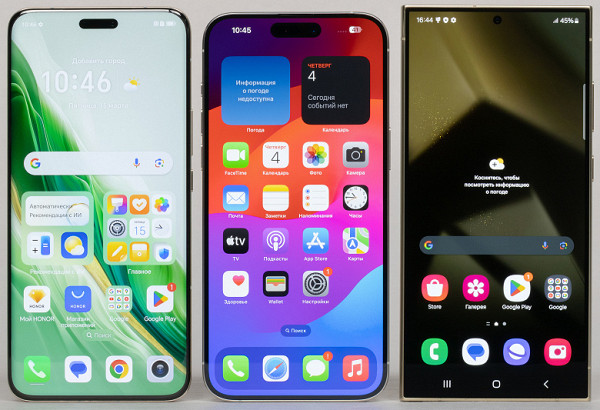
An important difference between the Chinese smartphone and its competitors is the curved edges of the screen. However, from an image quality point of view, this can be a noticeable disadvantage: flare and distortion may occur at such edges. At the same time, erroneous clicks on the curved edges of the screen are no longer a problem, since the smartphone ignores such touches.
If we talk about subjective feelings, then it is most convenient to hold the iPhone. It has flat sides and is not too wide. The Samsung is slightly wider and has slightly rounded sides. The Honor feels the slipperiest, although because it's the narrowest, it's the hardest to grip.
Apple and Samsung smartphones have flat and glass backs, while Honor has eco-leather (not too soft) and a complex shape: the surface rises closer to the camera block. The frame materials also differ: the iPhone and Galaxy S24 Ultra have it made of titanium, while the Magic6 Pro is presumably made of aluminum.
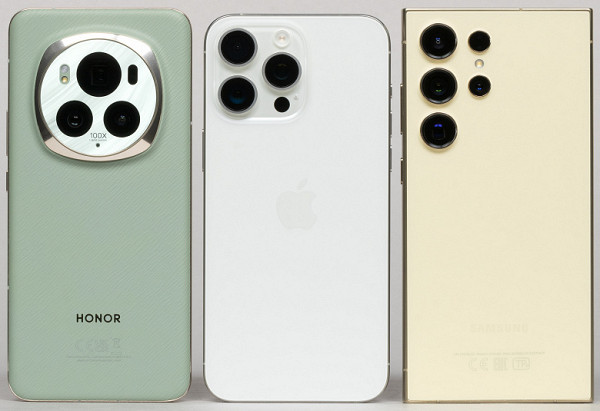
Cameras also play an important role in the design. The iPhone's photo unit has remained almost unchanged for several years: it is shifted to one side and contains three prominent lenses. Samsung has five separate modules, which can cause discomfort for trypophobes. Honor has three lenses combined into one block located in the middle. This distinguishes it from the Apple and Samsung options, since the Chinese smartphone can be safely used when it is lying on the table. In the case of an offset camera arrangement, the smartphone does not lie flat and sways when touched. To avoid this, you often have to use a cover. But this changes the feel of the device, hides its natural beauty and makes it thicker.

Honor Magic6 Pro is distinguished by the presence of honest stereo speakers at the ends. The iPhone 15 Pro Max and Galaxy S24 Ultra also have stereo sound, but one of the channels works through the earpiece. This is somewhat different from full stereo sound.
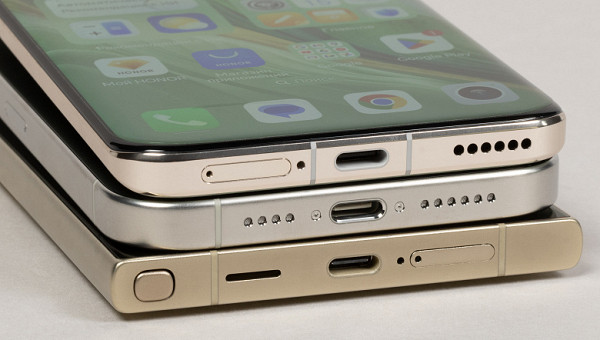
In the hand, all three smartphones feel approximately equally massive: their weight is in a narrow range from 220 to 230 g, and their thickness varies from 8.3 to 8.9 mm (Honor is the plumpest, the iPhone is the thinnest).
Hardware filling
Eastern flagships use the same chip — Qualcomm Snapdragon 8 Gen3, but the Korean device has a special version, slightly overclocked. This Qualcomm chip will be used in the most powerful smartphones from all manufacturers this year. Apple always has its own chip — this time it's the Apple A17 Pro.
On the Honor Magic6 Pro, you can enable performance mode in the battery settings, and for testing purposes we will use it, aiming for maximum processing power. If you are willing to lose 10%-15%, switch to this mode. The other two smartphones do not have this option.
| Apple iPhone 15 Pro Max (Apple A17 Pro) | Honor Magic6 Pro (Qualcomm Snapdragon 8 Gen3) | Samsung Galaxy S24 Ultra (Qualcomm Snapdragon 8 Gen3 for Galaxy) | |
|---|---|---|---|
| GeekBench 6 (scores, higher is better) | 2853/6911 | 2139/6582 | 2204/6999 |
| GFXBenchmark T-Rex (Onscreen, fps) | 59 | 91 | 119 |
| GFXBenchmark T-Rex (1080p Offscreen, fps) | 310 | 483 | 326 |
Differences in tests between smartphones running Qualcomm Snapdragon 8 Gen3 can be explained by slight overclocking and different efficiency of cooling systems under different loads. However, in everyday use this difference is almost unnoticeable. The iPhone also demonstrated comparable results in these tests and a similar «vigorous» system. Therefore, it is impossible to single out one winner here.
The RAM comparison also doesn't apply because the iPhone 15 Pro Max handles its available 8GB differently than Honor and Samsung smartphones do with their 12GB.
As for hardware, all three smartphones do not have a memory card slot, and the case protection against moisture and dust is the same — IP68. It's a draw again.
However, the iPhone 15 Pro Max has the advantage of a separate, customizable physical button on the left side.
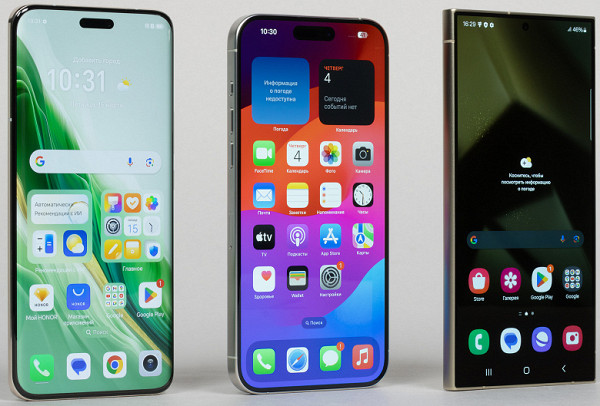
The Samsung Galaxy S24 Ultra offers something more interesting than just a button — it's an entire stylus that can be neatly hidden in the case. Many users really need this accessory, because in addition to handwriting input, it is suitable for highlighting text, translating text fragments on the fly, drawing, and controlling a smartphone from a distance using a button on the edge of the pen.
Both Android smartphones, including the Samsung Galaxy S24 Ultra, have two Nano-SIM slots but also support the use of eSIM. This also applies to Honor Magic6 Pro. However, the iPhone 15 Pro Max does not have a fingerprint scanner, but it does have a 3D Face ID scanner that works even in the dark. Both Android smartphones have an in-display fingerprint scanner, but face unlock is better supported on the Honor Magic6 Pro thanks to the ToF sensor, while the Samsung Galaxy S24 Ultra requires a finger swipe to enter some apps.
If we ignore the differences in supported satellite navigation systems, it remains to note support for Wi-Fi 7 in Honor and Samsung, as well as Wi-Fi 6e in the iPhone 15 Pro Max.
Screen
The smartphone displays have almost the same dimensions: 6.7 inches for the iPhone and 6.8 inches for the other two. Resolutions vary, however, and the Samsung Galaxy S24 Ultra has the highest pixel density at 505 ppi, compared to around 460 ppi for its competitors.
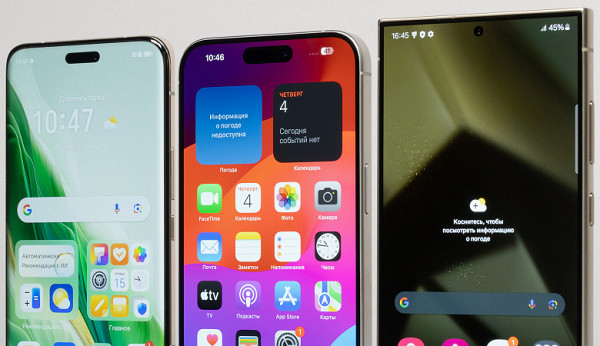
All three matrices are LTPO OLED. The first abbreviation indicates that the display is capable of changing the refresh rate up to 1 Hz to save power. The maximum refresh rate is also the same — 120 Hz.
It is worth noting the anti-glare properties of the Samsung Galaxy S24 Ultra screen, which remains black at any angle.
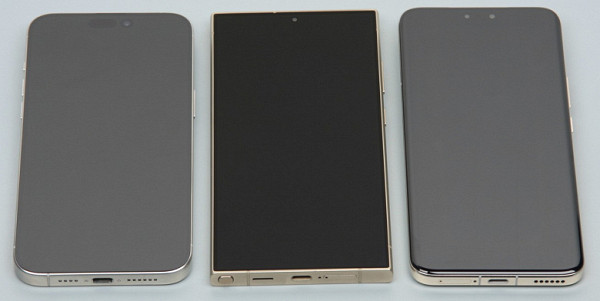
It is worth clarifying that in places where light “scratches” appear, the anti-glare properties of the screen are significantly reduced. Unfortunately, such “scratches” appear quite quickly.
Now let's move on to brightness measurements; the important ones for us are the minimum and maximum brightness.
| Apple iPhone 15 Pro Max | Honor Magic6 Pro | Samsung Galaxy S24 Ultra | |
|---|---|---|---|
| Minimum brightness, cd/m² | 2.4 | 2.0 | 0.9 |
| Maximum brightness (manual mode), cd/m² | 810 | 730 | 680 (high brightness mode) |
| Maximum brightness (auto), cd/m² | 1010 | 1200 | 1270 |
| Maximum brightness (HDR), cd/m² | 1550 | 1505 | 1270 |
Manufacturers claim peak brightnesses of up to 5000 cd/m² (for Honor), but it remains unclear under what conditions the display can achieve such dazzling brightness. Perhaps this actually only happens for brief moments.
Regarding flicker, the iPhone 15 Pro Max and Samsung Galaxy S24 Ultra use 480Hz PWM with noticeable duty cycle at low brightness, which can cause eye strain. The Honor Magic6 Pro has a better situation: it uses low-frequency modulation with a frequency of 360 Hz and a small duty cycle at any brightness level. In addition, there is modulation at a frequency of 4320 Hz, declared by the manufacturer, which, however, will not be noticeable to the user.
The color gamut of all smartphones is almost identical to or equal to sRGB. The iPhone also supports the Display P3 profile, and after adding test images we found that the smartphone had slightly better coverage than DCI-P3.
Camera
The iPhone 15 Pro Max and Honor Magic6 Pro each have three rear cameras: the main one, an “ultra-wide-angle” one and a “telephoto lens”. The Apple device offers 5x optical zoom thanks to its telephoto lens, while the Honor's is only 2.5x. In addition, the Korean smartphone is equipped with two telephoto lenses: one with 3x and the other with 5x zoom.

| Apple iPhone 15 Pro Max | Honor Magic6 Pro | Samsung Galaxy S24 Ultra | |
|---|---|---|---|
| The main module | 48 MP, 1/1.28″, f/1.78, OIS | 50 MP, 1/1.3″, f/1.4—f/2.0, OIS | 200 MP, 1/1.3″, f/1.7, OIS |
| Ultra wide angle module | 12 MP, 1/2.55″, f/2.2 | 50 MP, 1/2.88″, f/2.0 | 12 MP, 1/2.55″, f/2.2 |
| Telephoto | 2.5×, 80 MP, 1/1.49″, f/2.6, OIS | 3×, 10 MP, 1/3.52″, f/2.2, OIS | |
| 5×, 12 MP, 1/3.06″, f/2.8 | 5×, 50 MP, 1/2.52″, f/3.4, OIS |
Below are examples of photographs of identical scenes taken on three smartphones. Let's start with the main camera.
During the golden hour, the iPhone sought to maintain the warmth of the atmosphere, which was reflected in the image tinting characteristic of that time of day. At the same time, the details in the brightly lit spot on the building were well worked out. On a Samsung smartphone, such a spot turned out to be noticeably overexposed and lost details. Honor showed something average, but overall its image seemed a little lackluster.
Indoors, the iPhone seems to have illuminated the frame too brightly, but at the same time, all the scratches on the wooden surface are clearly visible (“Over-scraped!” the connoisseur is already screaming). With Samsung, some light areas have lost their midtones.
Here, as it became clear when analyzing the footage, the Honor smartphone got a frame with a direct beam. He decided to draw out all the shadows. If it seems that he has overdone it, then this can be corrected in the editor. The rest of the smartphones took fairly dark photos, but the iPhone had more shadow detail, while the Galaxy S24 Ultra turned out to have such areas flat.
And now some night shots:
I would like to say separately about the last series of photographs. Although the Honor Magic6 Pro produced the darkest photo, it is the only one that matches the actual view of the Catholic Cathedral an hour before dawn. The iPhone and Galaxy S24 Ultra created images that don't actually exist, turning night into day — not a good thing.
Now let's look at a set of photos taken with the ultra-wide-angle module during the day and at night:
When comparing zoom shots, you need to remember the differences in the equipment of smartphones. For example, five times magnification is typical for the iPhone 15 Pro Max and Samsung Galaxy S24 Ultra, while for the Honor Magic6 Pro you need to use a hybrid zoom. However, sometimes the results are not even inferior to pictures with pure optics:
All three smartphones have a macro function, switching to this mode automatically. On the iPhone you cannot control this function at all; on Samsung you don’t need to do this, but Honor sometimes switches from the main camera to the wide camera, which is designed for macro photography, so sometimes you have to interfere with the shooting process.
Finally, portrait mode with zoom:
Software
Operating systems and user interfaces on smartphones can be the subject of endless conversation, but they are not specific to specific models in this context of comparison.
Samsung promises seven generations of operating system and security updates for seven years for its flagship devices. The same update period is usually provided for Apple devices. Honor guarantees the Magic6 Pro four operating system updates and five years of security updates. Obviously, more is better, especially given the increasing lifespan of smartphone users.
Another important aspect is app store support. Apple has just begun to meet EU demands for freedom from the App Store monopoly.
Samsung and Honor smartphones have access to the Google Play Market application store, as well as other Google services. Although it has also removed apps from a number of Russian companies, Android users have plenty of alternatives. They can download and install the application from an APK file, use other application stores such as RuStore, NashStore, App Gallery, and also use third-party APK archives, such as APK Pure. Thus, with basic skills and computer literacy, an Android user can complete many tasks without much trouble.
Autonomy and charging
The leader in autonomy turned out to be Honor Magic6 Pro; its test results were truly impressive. This can probably be explained by having the largest battery among the three models. Despite its 550 milliamp-hour advantage, Samsung was never able to beat Apple.
| Apple iPhone 15 Pro Max | Honor Magic6 Pro | Samsung Galaxy S24 Ultra | |
|---|---|---|---|
| Battery capacity | 4441 mAh | 5600 mAh | 5000 mAh |
| Reading mode | 34 h. 00 m. | 38 h. 00 m. | 32:00 |
| Video mode | 28:00 | 30 h. 00 m. | 26:00 |
| 3D Game Mode | 8:30 a.m. | 9:00 a.m. | 8:30 a.m. |
Honor Magic6 Pro also surpasses its competitors in terms of maximum charging power. It comes with a powerful 100 W network adapter, and the smartphone itself is capable of receiving energy at speeds of up to 80 W.
Other manufacturers take a more environmentally responsible approach and offer to purchase chargers separately. The Samsung Galaxy S24 Ultra has a charging cap of 45W, and Apple doesn't specify a specific wattage, although tests show the iPhone 15 Pro Max can charge at around 25W.
It takes about 25-30 minutes to charge an iPhone halfway. For Samsung this process takes 20 minutes, and for Honor it takes a couple of minutes less.
And here are all the details about how energy is transferred to smartphones:
| Apple iPhone 15 Pro Max | Honor Magic6 Pro | Samsung Galaxy S24 Ultra | |
|---|---|---|---|
| Wired charging | 25 W | 80 W | 45 W |
| Wired reverse charging | 4.5 W | 5 W | Yes |
| Wireless charger | 15 W | 66 W | 15 W |
| Wireless reverse charging | No | Yes | 4.5 W |
Here the Chinese flagship outperforms its competitors on all counts.
conclusions
The iPhone 15 Pro Max occupies a cosmically high price niche, but compared to Android competitors it does not have any noticeable technical advantages. However, its sleek operating system, convenient ecosystem and abundance of useful applications remain behind the scenes. At the same time, performance, camera and charging speed are on par with comparable models.
The comparison between Honor and Samsung flagships gets complicated. Samsung's austere design, while it can be perceived in a variety of ways, presents both pros and cons. However, having two telephoto cameras on the Samsung Galaxy S24 Ultra is an advantage. With the Honor Magic6 Pro, although some people may not like the curved edges of the screen, charging and battery life are significant advantages. The screen quality of both models is comparable, and the difference in flicker may not be noticeable for less sensitive users (in the case of the Magic6 Pro, flicker is less noticeable). The Samsung Galaxy S24 Ultra stands out for its stylus, while the Honor Magic6 Pro offers one of the few front-facing ToF cameras on Android. In this case, there is no clear winner, since the choice depends on the individual preferences and needs of each user.

